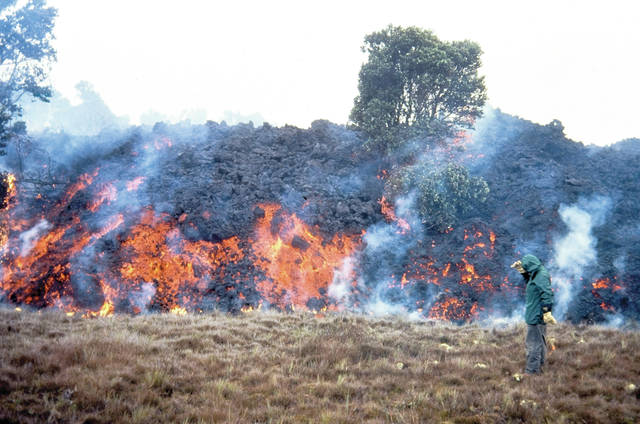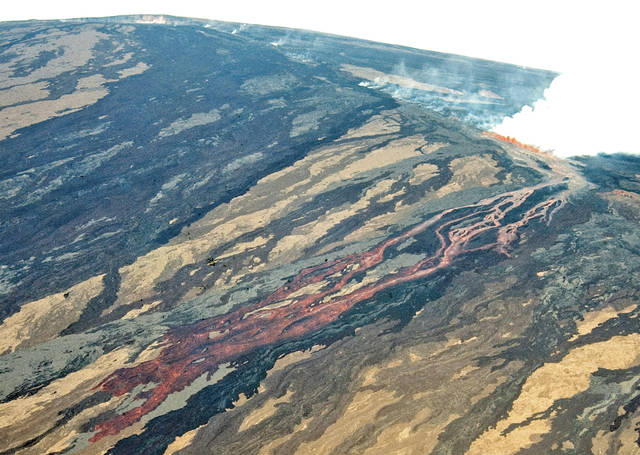Volcano Watch: Mauna Loa update — unrest continues, but the outcome is uncertain
On Sept. 17, 2015, the USGS Hawaiian Volcano Observatory upgraded the Volcano Alert Level for Mauna Loa, Hawaii Island’s largest volcano, from normal to advisory and the Aviation Color Code from green to yellow. Two years later, the volcano remains at advisory/yellow.
ADVERTISING
What’s up with Mauna Loa, and is any change in sight? Should residents relax or stay vigilant?
The 2015 alert level upgrade followed more than a year of inflation as magma slowly filled shallow reservoirs beneath the summit and upper Southwest Rift Zone of Mauna Loa. This was new behavior for the volcano following several years of no new magma input into the shallow plumbing system. At the same time, the rate of shallow, small earthquakes beneath the volcano was elevated, reflecting stresses that built as the volcano became pressurized.
Since then, rates of inflation and seismicity have waxed and waned, but have remained above what we consider to be long-term background levels. In addition, we have detected more small magnitude (less than M3) earthquakes beneath Mauna Loa than at any time since the previous eruption in 1984.
From 2013-15, shallow earthquakes clustered in locations similar to those that preceded Mauna Loa’s two most recent eruptions in 1975 and 1984. But the cumulative energy release — basically, the sum of the energy of each individual earthquake — remained relatively low compared to the years before the 1975 and 1984 eruptions. That low energy release was one indication that an eruption was at least many months to years away.
But today, the cumulative energy release of earthquakes since 2013 has essentially matched the pre-1975 and pre-1984 energy releases. Does this mean an eruption could occur within weeks to months?
Not likely.
If Mauna Loa follows the “script” of 1975 and 1984, before the volcano ramps up to an eruption, we would expect to see lots of small earthquakes occurring frequently beneath the summit — many more than are currently recorded — within a period of months. We also would expect at least an hour, or hours, of tremor (constant ground vibration) as a final warning that magma is on its way to the surface.
But how certain is it that Mauna Loa will follow the script of 1975 and 1984?
That’s the unknown.
We cannot discount the possibility that Mauna Loa will move from current conditions to eruption more quickly than it did in 1975 and 1984, potentially with only days to weeks of sharply increased activity.
It also remains possible that the current unrest will gradually cease without the volcano erupting, as it did during periods of unrest in 2002 and 2004. And so, we must continue to live with uncertainty about the timing and details of Mauna Loa’s next eruption.
In the meantime, HVO is closely monitoring the volcano and working with partner agencies and communities to prepare for a future eruption response. We also are identifying the key scientific questions we would seek to answer in the next eruption.
Since 1984, HVO has upgraded and added monitoring instrumentation, developing alarm systems to rapidly notify us of changes that might indicate a Mauna Loa eruption is imminent or in progress. We’ve also created map tools and other products to assist authorities and the public during the volcano’s next eruption.
Getting back to the question of should residents relax or stay vigilant, the answer is be prepared. Develop a family emergency plan and review emergency supplies. Know where you live and work with respect to Mauna Loa hazard zones.
More information about readying our island community for whatever Mauna Loa has in store for us can be found at https://volcanoes.usgs.gov/vhp/preparedness.html.
In Hawaii, we also face hurricanes, earthquakes, tsunamis, flooding and fires, so there are many possible emergencies year round. Preparing for one helps prepare for all.
The USGS fact sheet, “Mauna Loa — History, Hazards, and Risk of Living with the World’s Largest Volcano,” provides valuable information and is available online (https://pubs.usgs.gov/fs/2012/3104/fs2012-3104.pdf).
You also can stay informed about Mauna Loa through volcano updates and monitoring data posted on the HVO website (https://volcanoes.usgs.gov/hvo/). Or you can sign up to receive email updates automatically through the free USGS Volcano Notification Service (http://volcanoes.usgs.gov/vns/).
Volcano activity updates
This past week, Kilauea Volcano’s summit lava lake level fluctuated with summit inflation and deflation and ranged from about 31-53.5 m (102-175 ft) below the vent rim. On the East Rift Zone, the 61g flow remained active, with lava entering the ocean near Kamokuna and surface breakouts downslope of Pu‘u ‘O‘o. Widening cracks and slumping on the Kamokuna lava delta indicate its instability and potential for collapse. The 61g flows do not pose an immediate threat to nearby communities.
Mauna Loa is not erupting. During the past week, small-magnitude earthquakes continued to occur beneath the summit caldera and upper Southwest Rift Zone, primarily at depths of less than 5 km (3 mi), with some additional deeper events (5-13 km, or 3-8 mi). GPS measurements continue to show deformation related to inflation of a magma reservoir beneath the summit and upper Southwest Rift Zone. No significant changes in volcanic gas emissions were measured.
No earthquakes were reported felt in the Hawaiian Islands during the past week.
Visit the HVO website (https://volcanoes.usgs.gov/hvo) for past Volcano Watch articles, volcano updates and photos, recent earthquake info, and more. Call for summary updates at 808-967-8862 (Kilauea) or 808-967-8866 (Mauna Loa). Email questions to askHVO@usgs.gov.
Volcano Watch (http://hvo.wr.usgs.gov/volcanowatch/) is a weekly article and activity update written by U.S. Geological Survey Hawaiian Volcano Observatory scientists.




